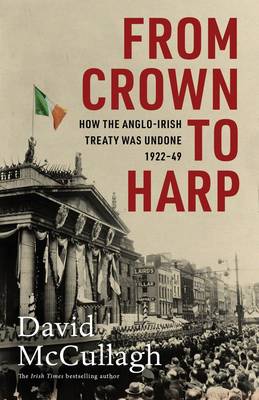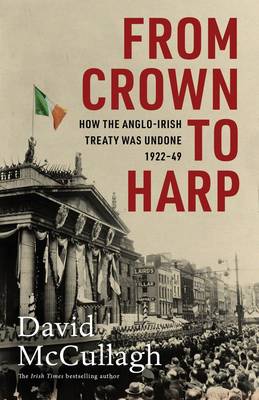
- Afhalen na 1 uur in een winkel met voorraad
- Gratis thuislevering in België vanaf € 30
- Ruim aanbod met 7 miljoen producten
- Afhalen na 1 uur in een winkel met voorraad
- Gratis thuislevering in België vanaf € 30
- Ruim aanbod met 7 miljoen producten
Zoeken
From Crown to Harp
How the Anglo-Irish Treaty Was Undone 1920-1949
David McCullagh
Hardcover | Engels
€ 37,95
+ 75 punten
Omschrijving
The crown was the symbol of British power in Ireland, and in December 1921 opponents of the Anglo-Irish Treaty claimed that its terms tied Ireland to the Crown forever. The new Irish Free State would be within the British Commonwealth, with limited sovereignty. And some believed it would stay that way if the Treaty was accepted.
And yet, within 16 years, Ireland had become a republic. A dozen years after that, it acquired the name as well and removed any ambiguity about its constitutional status by formally leaving the Commonwealth. And all without the firing of a shot.
This peaceful revolution had been achieved by a succession of governments of different parties and a cast of characters that included a monarch prepared to surrender his throne for love; a British prime minister who made Irish neutrality possible and another who did his best to bully or bribe Ireland into World War II. What had seemed impossible in 1921 had been achieved through relentless pressure, considerable skill and no small amount of luck. This is the story of how it happened.
And yet, within 16 years, Ireland had become a republic. A dozen years after that, it acquired the name as well and removed any ambiguity about its constitutional status by formally leaving the Commonwealth. And all without the firing of a shot.
This peaceful revolution had been achieved by a succession of governments of different parties and a cast of characters that included a monarch prepared to surrender his throne for love; a British prime minister who made Irish neutrality possible and another who did his best to bully or bribe Ireland into World War II. What had seemed impossible in 1921 had been achieved through relentless pressure, considerable skill and no small amount of luck. This is the story of how it happened.
Specificaties
Betrokkenen
- Auteur(s):
- Uitgeverij:
Inhoud
- Aantal bladzijden:
- 400
- Taal:
- Engels
Eigenschappen
- Productcode (EAN):
- 9781804581469
- Verschijningsdatum:
- 23/12/2025
- Uitvoering:
- Hardcover
- Formaat:
- Genaaid
- Afmetingen:
- 152 mm x 234 mm
- Gewicht:
- 782 g

Alleen bij Standaard Boekhandel
+ 75 punten op je klantenkaart van Standaard Boekhandel
Beoordelingen
We publiceren alleen reviews die voldoen aan de voorwaarden voor reviews. Bekijk onze voorwaarden voor reviews.








